Mapping the high burden areas of cholera in Nepal for potential use of oral cholera vaccine: An analysis of data from publications and routine surveillance systems
Chulwoo Rhee, Birendra Prasad Gupta, Bibek Kumar Lal, Jacqueline Kyungah Lim, T. Anh Wartel, Julia Lynch, Sushant Sahastrabuddhe
1International Vaccine Institute (IVI), Seoul, Republic of Korea
2Epidemiology and Disease Control Division, Department of Health Services, Ministry of Health and Population, Kathmandu, Nepal
ABSTRACT Objective: To assess the extent of existing published evidence on cholera and to characterize the epidemiologic data of cholera in Nepal.Methods: We conducted a literature scoping review by summarizing published literature reporting on cholera in Nepal from January 1946 to March 2019 in online databases: MEDLINE, Embase,Cochrane, and Global Health. Additionally, we reviewed national surveillance data on clinically diagnosed and laboratory confirmed cholera reported by the Ministry of Health and Population.Results: Most of the published studies were conducted predominantly in Kathmandu Valley during the rainy season;however, outbreaks have been reported in other parts of Nepal including Terai, Hilly and Mountain regions. Our literature review exhibited that all age groups were affected by cholera, but particularly children and young adults were at-risk age groups in Nepal. Vibrio cholerae serogroup O1, biotype El Tor, serotype Ogawa has been predominantly isolated with an emergence of resistant strains since 1996. Two mass vaccination campaigns using oral cholera vaccines were conducted: Rautahat district in 2014 and Banke district in 2017.Conclusions: Capacity building for a nation wide systematic cholera surveillance with rapid and reliable diagnosis is needed to better estimate the burden of cholera and identify geographically at-risk areas associated with the disease in Nepal. It is essential for developing an adequate policy on oral cholera vaccine introduction and effective water, sanitation and hygiene interventions.
KEYWORDS: Cholera; Outbreak; Oral cholera vaccine;Surveillance; Nepal
1. Introduction
Cholera is an acute intestinal infection caused by ingestion of food or water contaminated with the bacteria Vibrio (V.) cholerae[1], a gram negative flagellate bacterium commonly known as V. cholerae O1 and also by V. cholerae O139. A new virulent variant strain of V. cholerae O1 EL Tor has been replacing classical biotype in sub-Saharan Africa and South/South-East Asia[2]. Outbreaks of cholera mostly occur in low- and middle-income countries affecting both children and adults with limited access to clean drinking water and proper sanitation[3]. It is estimated that 1.4 billion people are at risk of acquiring cholera, resulting in 3-5 million cholera cases and 100 000-130 000 deaths per year globally[4,5]. Currently, the burden of cholera is the highest in Africa and parts of Asia, responsible for 99% of global cholera cases[6].
Nepal, a land-locked country with geographical and cultural proximity to the Ganges plain, is comprised of 3-ecological zones:Mountain, Hilly and Terai regions. The population of Nepal is estimated to be approximately 29 million in 2020 based on the 2017 Revision of World Population Prospects[7] with the highest density in the Terai region followed by Hilly and Mountain regions respectively. According to the latest report published by the United Nations Development Programme in 2018, Nepal ranks 149th among 189 countries in terms of Human Development Index,with 80.7% of population residing in rural areas mostly relying on primitive sources for drinking water[8]. In 2017, the neonatal mortality rate per 1 000 live births was 21[9], and under 5 years mortality rate per 1 000 live births was 34[10], which is below the Sustainable Development Goals target (Neonatal mortality per 1 000 live births is 12 and 25 deaths per 1 000 live births for under-5 mortality).
The first recorded cholera outbreak in Nepal dates back to 1823[11],followed by series of epidemics including the current seventh cholera pandemic which is estimated to have emerged in South Asia in 1961 and spread in the region and inter-continentally[12]. According to the updated global burden of cholera in endemic countries, it was estimated that over 18 million people, more than 60% of the Nepalese population, are at risk of cholera with an incidence rate of 1.64 per 1 000 resulting in an estimated 30 379 cases annually[13].Although these estimates provide much needed information on general disease burden of cholera in Nepal, data gaps remain on a sub-national level to inform the location of cholera “hotspots” in Nepal where likelihood of outbreak is the highest. As part of the efforts to properly address cholera outbreaks, the Nepal Ministry of Health and Population (MoHP) has been conducting surveillance for cholera through the Health Management Information System(HMIS) and Early Warning and Reporting System (EWARS) since 1997[14].
Despite several reported outbreaks of cholera, epidemiologic data on cholera in Nepal are still limited. Yet, in order to accomplish goals set forth by the World Health Organization (WHO)’s Ending Cholera; A Global Roadmap to 2030[15], identifying high-risk populations or regions for cholera in Nepal remains an important public health priority. Therefore, we conducted a literature scoping review to characterize the epidemiology of cholera in Nepal and identify current knowledge gaps. Furthermore, we also reviewed recent data from the HMIS and EWARS to identify areas with a high probability of significant cholera disease burden. This review aimed to support informed decision making on strengthening the national cholera surveillance system, and to guide health authorities for implementation of appropriate public health measures, including the use of oral cholera vaccines (OCVs), to mitigate cholera outbreaks.
2. Materials and methods
2.1. Literature search and eligibility criteria
A literature search of online databases including Medline, Embase,Cochrane, and Global Health was conducted to identify publications on cholera in Nepal from January 1946 to March 2019. Search terms were “cholera”, “diagnosis”, “epidemiology”, “outbreak”and “Nepal”. Title and abstract of identified publications in English language were screened to determine whether any data on cholera in Nepal were reported. We included publications that reported cholera as an etiology of acute diarrheal or acute gastroenteritis cases detected through hospital-/laboratory-/community-based surveillance/studies or any cholera outbreak reports in Nepal. We excluded any review articles, case reports, presenting data only on travel-associated cases of cholera (imported or exported cases of cholera), and if no human cholera data was presented (Figure 1).
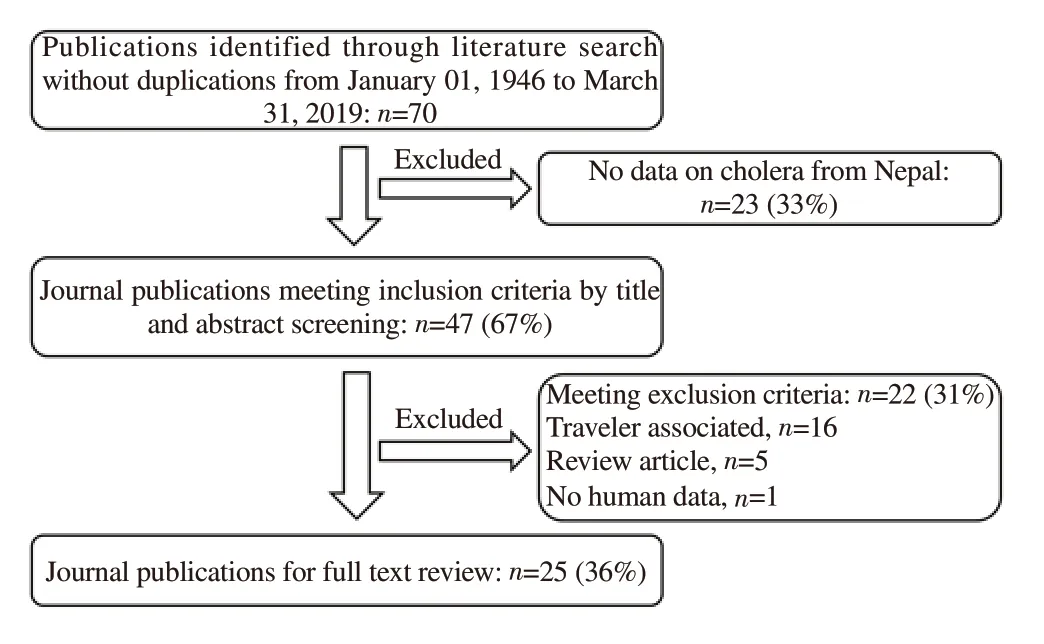
Figure 1. Literature search and screening process used to determine the eligibility of publications on cholera in Nepal.
2.2. Review of national surveillance data
The HMIS routinely collects clinically diagnosed cholera cases from all public health facilities across the country in Nepal(approximately 7 000 health facilities), whereas the EWARS focuses on six priority diseases including laboratory-confirmed cholera from participating 118 sentinel sites throughout the country[14].In HMIS and EWARS, suspected cholera case is defined as: any person aged 3 years or above with moderate or severe dehydration from 3 or more episodes of acute watery diarrhea per day (24 h),with or without vomiting[14]; similar to the WHO’s standard clinical case definition of cholera; a patient aged 5 years or more with acute watery diarrhea, with or without vomiting[16]. Suspected cholera case that has V. cholerae isolated from their stool by bacterial culture or reverse transcription polymerase chain reaction (RT-PCR) is defined as a confirmed case[14]. We retrieved the data from the HMIS from 2011 to 2016 and the EWARS from 2014 to 2018 as of 29 May 2019 with permission from the Nepal MoHP Epidemiology and Disease Control Division (EDCD). Data for this manuscript only uses what is currently publicly available for HMIS and what the Ministry has approved for EWARS. At the time of research, data on HMIS till 2016 was only publicly available through an annual report. EWARS data was approved till 2018. Therefore there is difference between the period for datasets. As both EWARS and HMIS are on-going routine public health surveillance systems, use of publicly available data does not warrant additional ethical approval. We also included a number of laboratory confirmed cholera cases from outbreaks that were officially reported by the MoHP from 2009 to 2016. At the time of research, the Ministry has officially labelled these cholera cases as “outbreak” through the official report.
2.3. Data abstraction and analysis
Relevant data on cholera from publications screened for our final literature review were collected using a Microsoft Excel 2007.Data collection included the year of publication, study period,methodology, number of laboratory confirmed cases, demographics,and other noteworthy findings such as findings on antimicrobial resistant strain, and proportion of co-infection with other pathogens.All analyses and data visualization for this review were performed using Microsoft Excel 2007.
3. Results
3.1. Geographical distribution of cholera in Nepal
The first recorded cholera outbreak in Nepal took place in 1823,followed by a series of epidemics occurring thereafter in the Kathmandu Valley in 1831, 1843, 1856, 1862, 1887. The first scientific report on cholera in Nepal was published in May 1886[11].However, for nearly a century thereafter there were few reports of cholera following these earlier notices[17,18]. The MoHP reported to the WHO that the cholera outbreak of the year 1991 was multicausal gastroenteritis, which resulted in altogether 92 000 cases and 1 800 deaths[19]. In 1993, suspected cholera cases reported to the WHO were at the highest of 30 648, where all major cholera events occurred in Terai and Hilly regions of Nepal[19].
Since then, sporadic cases and/or outbreaks have been reported,demonstrating on-going circulation of cholera in Nepal (Table 1)[20-28].For the cholera outbreak in 1991, among five administrative regionsin the country, morbidity due to gastroenteritis was the highest in the Eastern region (753 per 100 000) while the far west developmental region reported the highest mortality (29.2 per 100 000 per inhabitants) with case fatality rate of 5.9%, nearly 3 times higher than the national case fatality rate (2.0%)[19]. More recently, according to the HMIS, the Parsa and Siraha districts in the Terai region (Province 2) of Nepal reported the highest number of clinically diagnosed cholera cases in 2015-2016 (Table S1). The clinically diagnosed cholera was reported from as low as 300 m below sea level of Terai region (Morang, Sunsari, Dhanusha, Mahottari, Rautahat, Chitwan,Banke and Kailali district), to Kathmandu Valleys of upland Hill and Mountain regions at an altitude of 2 500 m above sea level in 2016(Figure 2 and Table S1).

Table 1. Summary of selected publications reported on outbreaks of cholera in Nepal since 1993.
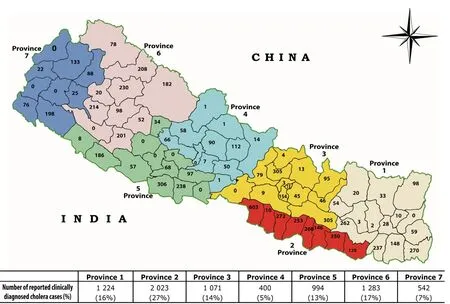
Figure 2. Reported number of clinically diagnosed cholera cases to the Health Management Information System by district, 2016*. *Seven provinces are shown with different colors in the map and clinically diagnosed cholera cases with a total number of cases per province are shown in the table.
Reported clinically diagnosed cholera cases to HMIS is shown by region and year from in Figure 3. The Eastern region reported the highest case numbers in 2011, but the Central region has experienced most cases since 2013. Due to the re-classification of administrative geographic division of Nepal in 2016, from 5 regions to 7 provinces,the number of cholera cases per province in 2016 is shown separately in Figure 2. Similar to 2012-2015, the highest number of cases was reported from districts previously classified as the Central region. A detailed number of acute gastroenteritis and clinical cholera cases per district for 2015 and 2016 are shown in Table S1.
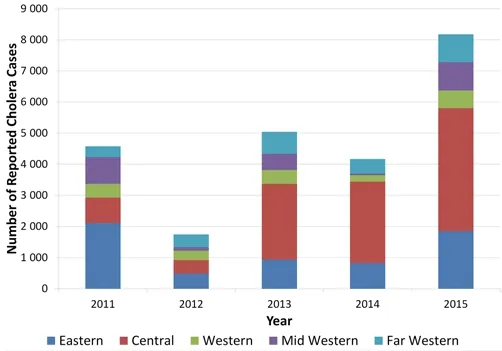
Figure 3. Reported number of clinically diagnosed cholera cases to the Health Management Information System by region, 2011-2015. Recategorization of districts from five administrative regions to seven administrative provinces are shown in Table S1.
3.2. Demographic distribution of cholera cases
All age groups were found to be affected by cholera, but of the studies that reported cases of cholera by age group, children and young adults were consistently reported to be at the highest risk[24-26]. One study reported the age group of 15-30 years were the most affected[24], while another study reported the highest number of cases among those were 20-39 years[26].
3.3. Seasonality
In Nepal, the dry season typically starts in the months of March-April and continues until May-June, while the rainy season starts in June-July and continues until September-October. During the dry season, there is a scarcity of water in the hills, while in the rainy season often there is flooding leading to contamination of water sources[19]. Most of the cholera outbreaks reported in Nepal occurred during the rainy season, May through August.
3.4. Laboratory confirmation
Proportion of stool samples from which V. cholerae was isolated during an outbreak ranged from 18.7%[27] to as high as 41.4%[20].V. cholerae serogroup O1, biotype El Tor, serotype Ogawa was consistently reported as the dominant circulating agent for cholera.One study on 1 107 diarrheal children reported Ogawa being the most common type (199/784, 25.4%) followed by Hikojima(111/784, 14.2%) and Inaba (4/784, 0.5%)[21]. Co-infection was reported to be common across studies, isolating parasites (Giardia lamblia and Ascaris lumbricoides) and other bacterial pathogens such as Escherichia coli[22,25]. Laboratory-confirmed cholera cases reported by the MoHP during outbreaks from 2009 to 2016 are shown in Table 2 and laboratory-confirmed cases reported through the EWARS from 2014-2018 are shown in Table 3.
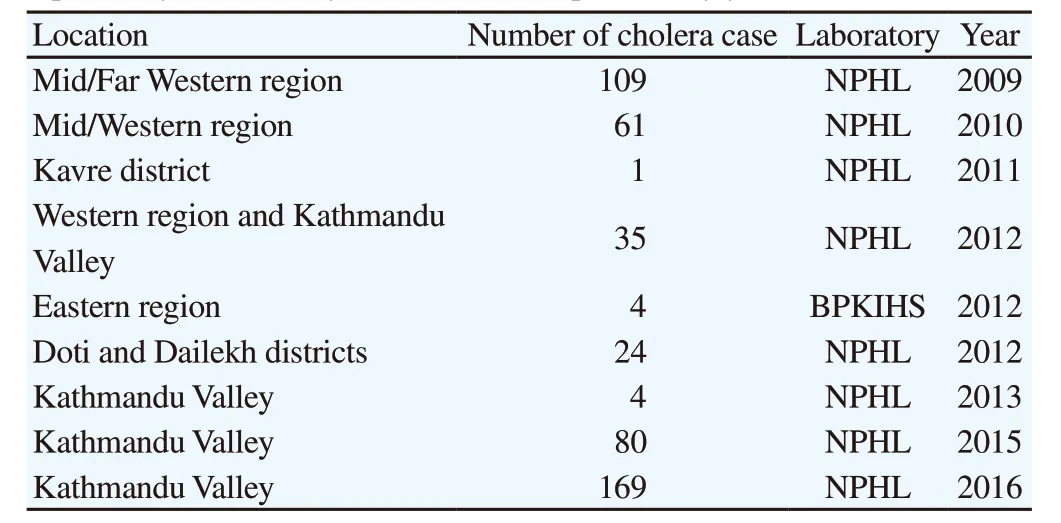
Table 2. Laboratory-confirmed cholera cases during outbreaks officially reported by the Ministry of Health and Population by year, 2009-2016.

Table 3. Laboratory-confirmed cholera cases in the Early Warning and Reporting System by geographical region, 2014-2018.
3.5. Antibiotic resistance
Of the few studies that reported antibiotic testing results, Ise et al. were the first to discuss antimicrobial resistance of V. cholerae in Nepal, documenting cholera strains with reduced sensitivity to nalidixic acid, co-trimoxazole, ampicillin, and cephalexin in 1996[20].In 2004, cholera isolated during an outbreak in the Kavre district were found to be completely resistant to co-trimoxazole, while sensitive to all other antibiotics tested[22]. Another study conducted in 2004 also isolated cholera resistance to nalidixic acid[29]. By 2008,cholera isolates from an outbreak in Kathmandu (and later in Saptari and Jajarkot) were found to be 100% resistant to furazolidone in addition to co-trimoxazole and nalidixic aci[23-25,30]. A later study identified this resistance pattern to be present in Nepal as early as 2005[31]. All 522 V. cholerae isolates collected from 2007 to 2010 at 10 hospitals in Nepal were reported to be resistant to nalidixic acid and furazolidone and 90%, 21%, 16%, and 4% were resistance to co-trimoxazole, tetracycline, erythromycin, and ciprofloxacin respectively[32]. A multi-drug resistant strain, defined as absence of susceptibility to two or more classes of antibiotics, of V. cholerae was isolated from 6.5% of 116 stool specimens tested[26], followed by another report on multi-drug resistance V. cholerae in 2012[33].
3.6. OCV vaccination campaigns
Only a few OCV campaigns have been conducted in Nepal despite recurrent outbreaks of cholera. OCVs were first introduced to Nepal in 2014 for a reactive vaccination campaign in Rautahat district shortly after a cholera outbreak[34]. OCVs were deployed preemptively to internally-displaced persons in camps at Nuwakot and Dhading districts after the 2015 earthquakes, delivering 20 652 doses to 10 084 people (105% coverage for the first dose and 96%coverage for the second)[34]. Shanchol? OCV was used in these campaigns as it was the only OCV available via the WHO’s global stockpile in 2014[35]. In early 2017, an OCV campaign in Banke district was conducted, coordinated by the Nepal Ministry of Health,International Vaccine Institute, and Delivering Oral Cholera Vaccine Effectively[36]. This was the largest OCV mass vaccination campaign so far, using 50 000 doses of Euvichol? donated by the Rotary Club of Seoul. The two-dose coverage was reported to be 74%, and 85%for one-dose.
4. Discussion
In this review, we aimed to provide a summary of publications reported in peer-reviewed journals on cholera in Nepal, as well as reviewing recent surveillance reports. This review confirms that cholera has been circulating in Nepal for decades and poses a high risk for future outbreaks. Despite our effort to characterize the epidemiology of cholera in Nepal, current available data on cholera in Nepal are insufficient as a result of limited surveillance and diagnostic infrastructure and capabilities. The lack of high quality data consequently affects implementation of multi-sectoral public health interventions as cholera hotspots have not been accurately identified.
Cholera is a growing global public health threat due to urbanization,climate change, cross-border transmission, and destruction of infrastructure by natural disasters like earthquakes in Haiti and Nepal[37,38]. In Nepal, the major causes of cholera are the poor sanitation systems, consumption of contaminated drinking water,poor hygiene practices, overcrowding, and explosive urbanization,especially in Kathmandu Valley and Terai[39,40]. Yet, in the majority of the countries where cholera is endemic, the disease surveillance is poor resulting in gross under reporting of cholera incidence. For proper understanding of disease burden and true epidemiological patterns in specific areas/regions/countries, a robust surveillance system is warranted[41]. However, countries like Nepal face practical challenges in setting up a system of cholera disease surveillance and response due to geographical remoteness, shortage of skilled health care workers, lack of laboratory infrastructure, and financial constraints[14].
Nepal remains at high risk for outbreaks due to a steady increase in urban population density accompanied by an inadequate supply of safe drinking water and lack of improved sanitation. Perhaps most importantly, Nepal faces flooding and landslides during the rainy season every year which often lead to the breakdown of the already fragile water and sanitation infrastructure. All these complex factors(geographical, demographical, economical, and infrastructural)raise the possibility of cholera outbreaks, which are challenging to prevent and control. Outbreaks of cholera are reported in different development regions/province of the country every year, causing the location of outbreaks difficult to predict. However, cases have been reliably reported within the Kathmandu Valley and Province 2 every year, making them priority areas for cholera control in Nepal[14].
Along with basic water, sanitation, and hygiene interventions,use of OCV can complement ongoing control measures and can be implemented more quickly than improvements in sanitation infrastructure. Currently there are two types of OCVs WHO prequalified: killed whole cell monovalent (O1) vaccine with a recombinant B subunit of cholera toxin[42], and killed modified whole cell bivalent (O1 and O139) vaccine without a recombinant B subunit of cholera toxin[43,44]. A systematic review reported direct effectiveness of OCVs, providing protection for at least 3 years when administered with a two-dose schedule with 2 weeks interval,and relatively shorter protection of two years duration has been demonstrated with a single dose for individuals over five years of age[45].
Despite our effort to include existing publications and reports on cholera in Nepal, insufficient data limit a detailed understanding of the cholera epidemiology in Nepal. In order to reduce Nepal cholera deaths by 90% by 2030 as set forth by the WHO[15], building a robust surveillance system for early detection should be prioritized.Rolling out of rapid diagnostic kits for cholera to ensure prompt field epidemiologic investigation has been suggested through earlier experiences in post-earthquake Nepal[46]. Lessons learned from a recent cholera outbreak in Gaidataar highlighted the need for coordinated multi-disciplinary approach towards strengthening the preparedness and prevention system for cholera epidemics[47]. A recent meeting of country representatives from ten Asian choleraprone countries reported that Nepal requires identification of high risk groups by strengthening surveillance system[48]. Once cholera hotspots are identified, integrated public health interventions should be deployed that include use of OCV and improvements in water,sanitation, and hygiene. Inter-sectoral collaboration is a key for effective cholera control which requires both political and financial commitments.
Our study is subject to several limitations. First, our literature search may have missed publications on cholera in Nepal if cholera wasn’t explicitly mentioned on title or abstract. Secondly, as we aimed to summarize the extent of existing evidences on cholera in Nepal,we have not conducted quality assessment and grading of evidence on included publications. However, this has allowed us to include as many publications as possible to describe the epidemiology of cholera in Nepal and identify knowledge gaps. Thirdly, since we were only able to use publically available national public health surveillance data, we were not able to provide population-based estimates related to cholera.
Nepal has been endemic for cholera with outbreaks being reported episodically, yet our understanding of actual disease burden is limited by an incomplete surveillance system and diagnostic capacity. Efforts are needed in order to develop improved, proactive,laboratory-based surveillance systems that can identify cholera hotspots and forecast impending cholera outbreak in this country.This will alert the public to take action and physicians to diagnose at an early stage for effective treatment of cholera cases in different regions of Nepal. The implementation of systematic cholera surveillance for reliable diagnosis is required to identify the actual disease burden including age stratified data, to understand the geographical disease distribution, and inform the priority areas to target for cholera prevention. Though improved water and sanitation systems are the ultimate solution to eliminate cholera, this requires sustained long term investments. Currently available vaccines are effective in preventing cholera and controlling outbreaks and should be used proactively.
Conflict of interest statement
The authors declare no competing or conflict of interests.
Acknowledgments
We thank the staff of Epidemiology and Disease Control Division(EDCD), Ministry of Health and Population, Nepal who helped us in data collection for the manuscript. We also thank Dr. Anuj Bhattachan for the contribution to the manuscript and Mr. Krishna Raj Pandey, Statistical Officer/Demographer at Disease Surveillance and Research Section of EDCD for providing cholera data available in EWARS.
Funding
This work was supported by the Governments of Korea, Sweden,India, and Bill and Melinda Gates Foundation (#OPP52797).
Authors’ contributions
BKL, JAL, and SS conceived and designed the study. CR, and BPG were responsible for literature search and screening. CR, BPG, and BKL were responsible for data collection and analyses. CR, BPG,BKL, SS, JKL, JAL, TAW contributed to data interpretation. CR and BPG drafted the manuscript and BKL, SS, JKL, JAL, TAW critically revised the manuscript.
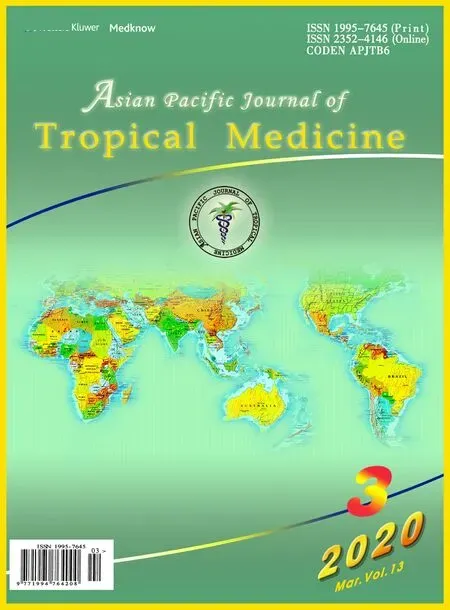 Asian Pacific Journal of Tropical Medicine2020年3期
Asian Pacific Journal of Tropical Medicine2020年3期
- Asian Pacific Journal of Tropical Medicine的其它文章
- Dose prediction of lopinavir/ritonavir for 2019-novel coronavirus (2019-nCoV)infection based on mathematic modeling
- Novel coronavirus (2019-nCoV) update: What we know and what is unknown
- Imported cases of 2019-novel coronavirus (2019-nCoV) infections in Thailand:Mathematical modelling of the outbreak
- Molecular isolation and identification of Mycobacterium avium subsp. hominissuis in Didelphis virginiana from Hidalgo, Mexico
- Blastocystis incidence, spontaneous clearance, persistence and risk factors in a rural community in Thailand: A prospective cohort study
- Etiologies of tropical acute febrile illness in West Pahang, Malaysia: A prospective observational study
